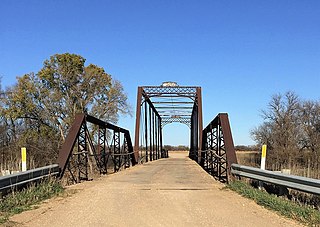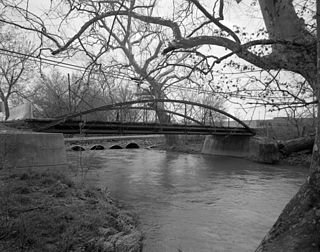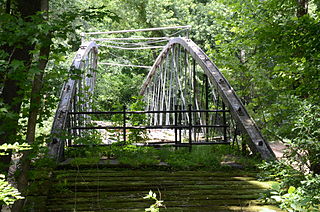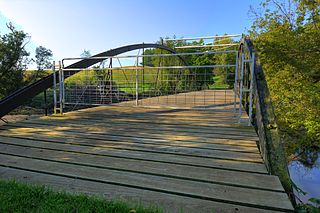
The Phoenix Iron Works, located in Phoenixville, Pennsylvania, was a manufacturer of iron and related products during the 19th century and early 20th century. Phoenix Iron Company was a major producer of cannon for the Union Army during the American Civil War. The company also produced the Phoenix column, an advance in construction material. Company facilities are a core component of the Phoenixville Historic District, a National Register of Historic Places site that was in 2006 recognized as a historic landmark by ASM International.

The Tioronda Bridge once carried South Avenue in Beacon, New York, across Fishkill Creek. Built between 1869 and 1873 by the Ohio Bridge Company, it was demolished by the city in December 2006. The bridge had been listed on the National Register of Historic Places in 1976, but a decade later had deteriorated to the point that it had to be closed.

Pott's Ford Bridge is a bridge 1/2 mile south of Glasco, Kansas, USA that spans the Solomon River in Cloud County, Kansas. It has a wooden deck with three bowstring pony trusses and one Pratt pony truss. The lengths of the trusses are 48 feet (15 m), 46 feet (14 m), and 149 feet (45 m) for the bowstring trusses, and 72 feet (22 m) for the Pratt truss. It was built in 1884 by the Wrought Iron Bridge Company of Canton, Ohio.

Shaw Bridge, also known as Double-Span Whipple Bowstring Truss Bridge, is a historic bridge in Claverack, New York, United States. It carried Van Wyck Lane over Claverack Creek, but is now closed to all traffic, even pedestrians. It is "a structure of outstanding importance to the history of American engineering and transportation technology." Specifically designed by John D. Hutchinson, the bridge employs the basic design of Squire Whipple. It is the only extant "double" Whipple bowstring truss bridge in the U.S., having two identical spans placed in series over a common pier.

The Waverly Street Bridge, also called the Westernport Bowstring Arch Truss Bridge, was a historic steel bowstring truss bridge at Westernport, Allegany County, Maryland, United States. It carried vehicular traffic on Waverly Street over George's Creek. The bridge had a span length of 108 feet (33 m). It was built in 1892, by the King Bridge Company of Cleveland, Ohio.

The Crum Road Bridge is a historic bridge near Frederick, Frederick County, Maryland, United States. It spanned Israel Creek southeast of Walkersville. The bridge is an iron bowstring pony bridge that is 62 feet (19 m) in length and 15.8 feet (4.8 m) in width. The Crum Road Bridge was built on or about 1875, and was probably constructed by the King Iron Bridge Company of Cleveland, Ohio.

Bridge L-158 is a disused railroad bridge over Muscoot Reservoir near Goldens Bridge, New York, United States. Built to carry New York Central Railroad traffic over Rondout Creek near Kingston, it was moved to its current location in 1904.

The Whipple Cast and Wrought Iron Bowstring Truss Bridge, is located near the entrance to Stevens Farm in southwestern Albany, New York, United States. It was built in 1867, but not moved to its present location until 1899. It is one of the oldest surviving iron bridges in the county, one of the few that use both cast and wrought iron and one of only two surviving examples of the Whipple bowstring truss type. In 1971 it was listed on the National Register of Historic Places, the only bridge in the city of Albany so far to be listed individually.

Bridge No. 4, near La Crosse, Wisconsin, United States, was built in 1902. It is a bowstring truss bridge built by the Clinton Bridge Company. It was listed on the National Register of Historic Places in 1980 and documented by the Historic American Engineering Record in 1987.

Bowstring Truss Bridge, also known as the Roaring Run Bowstring Truss Bridge and King Tubular Arch Truss Bridge, is a historic bowstring truss bridge located at the Ironto Rest Area near Ironto, Montgomery County, Virginia. It was built by the King Bridge Company in 1878, and is a single-span, four-panel tubular arch pony truss. It measures 55 feet (17 m) long, 12 feet (3.7 m) wide, and 6 feet 6 inches (1.98 m) high with an open roadway width of approximately 9 feet 6 inches (2.90 m). The bridge was partially disassembled and moved from its original location to a second site during the 1930s, where it remained until moved to its current location in 1977.

Nodaway River Bridge is located west of Grant, Iowa, United States. It spans an arm of a small pond in Pilot Grove County Park for 70 feet (21 m). The Montgomery County Board of Supervisors accepted a petition from S. M. Smith to build a bridge over the Nodaway River south of Grant in June 1876, and another bridge over the Nishnabotna River at the same time. The county contracted with the Missouri Valley Bridge & Iron Co. of Leavenworth, Kansas, to design and build the Nodaway River bridge, which was completed later the same year for $1,000. The bridge consists of a single-span Bowstring arch-truss with a wood deck. It remained in use as a road bridge until 1968, when it was moved to the park for use as a pedestrian bridge. Even though it is no longer in its historic location and used for its historic function, the bridge was listed on the National Register of Historic Places in 1998 as an example of early transportation development in Iowa.

The Springfield Bridge is a historic bowstring truss bridge, located in Beaverfork Lake Park in Conway, Arkansas, USA. It originally spanned Cadron Creek in rural Faulkner County east of Springfield. It is 188 feet (57 m) long, set on stone abutments, with tubular metal top chords that rise 15 feet (4.6 m) above the bottom chords. Built circa 1871–74, it is the oldest documented highway bridge in the state and its only documented bowstring arch bridge.
The Beaver Creek Bridge was located northwest of Schleswig, Iowa, United States. It spanned Beaver Creek for 134 feet (41 m). Steel was in short supply during World War II as a part of the war effort. Many bridges built across the state were built in this era with timber, especially small-scale bridges. Heavy flooding washed out 27 bridges and culverts in Crawford County in May 1945. The county board of supervisors used emergency funds to build new bridges. They bought several steel superstructures from the Des Moines Steel Company to replace the wash-out spans. The bowstring arch-truss structures appear to have been designed by H. Gene McKeown, a civil engineer from Council Bluffs. This bridge was one of several similar structures built in the county. The bridge was listed on the National Register of Historic Places in 1998, and it was delisted in 2020.
The Buck Grove Bridge is located southeast of Buck Grove, Iowa, United States. It spans Buck Creek for 70 feet (21 m). Steel was in short supply during World War II as a part of the war effort. Many bridges built across the state were built in this era with timber, especially small-scale bridges. Heavy flooding washed out 27 bridges and culverts in Crawford County in May 1945. The county board of supervisors used emergency funds to build new bridges. They bought several steel superstructures from the Des Moines Steel Company to replace the wash-out spans. The bowstring arch-truss structures appear to have been designed by H. Gene McKeown, a civil engineer from Council Bluffs. This bridge is one several similar structures built in the county, and one of five that still remain. The bridge was listed on the National Register of Historic Places in 1998.
The Lawrence Bridge is a historic structure located in Jackson Junction, Iowa, United States. It spans the Little Turkey River for 84 feet (26 m). This bridge was designed, fabricated and built by the Wrought Iron Bridge Company of Canton, Ohio for $2,519.35. This and the Upper Bluffton Bridge were built at the same time, and it marked the first time that Winneshiek County had longer-span trusses built at rural river crossings instead of the smaller bowstring truss bridges. This bridge was listed on the National Register of Historic Places in 1998. It is now privately owned, and located on an abandoned portion of 336th Avenue over the Little Turkey River.
The Gilliece Bridge was a historic structure located west of Bluffton, Iowa, United States. It spanned the Upper Iowa River for 151 feet (46 m). In 1872 Winneshiek County started to replace its older short span timber and stone bridges. This Bowstring through arch-truss bridge was designed, fabricated, and built by the Wrought Iron Bridge Company of Canton, Ohio in 1874 for $6,969.47. Thomas Dwyer, a local stonemason, built the masonry abutments. The bridge was listed on the National Register of Historic Places in 1998. The bridge was destroyed in May 2017 by an overweight truck which was driven onto it despite the posted weight limit of three tons.
The Green Mill Ford Bridge was a historic structure located northeast of Janesville, Iowa, United States. It spanned the Cedar River for 244 feet (74 m). This Bowstring through arch-truss bridge was originally erected in Waverly, Iowa after the Bremer County Board of Supervisors found the previous timber structure bridge was worn out. It was designed and erected by the King Iron Bridge and Manufacturing Co. of Cleveland. John R. Price and Brothers built the substructure. The total cost for constructing the bridge was $16,000. It remained in service at this location until 1898 when it was replaced by a girder bridge. The bow string trusses were dismantled three years later. One of the spans was erected over the Cedar River in Franklin Township, while the remaining two spans were erected here in Jefferson Township. The Green Mill Ford Bridge was closed to traffic in 1988. The bridge was listed on the National Register of Historic Places (NRHP) in 1998.

Hale Bridge is a historic structure located south of Anamosa, Iowa, United States. It spans the Wapsipinicon River for 296 feet (90 m). It is an example of a bowstring through-arch truss bridge. Perhaps thousands of these bridges were built in Iowa in the late 1860s through the 1870s. However, by 1992, fewer than twenty survive.

Lower Road Bridge is a historic structure located northwest of Anamosa, Iowa, United States. It spans Buffalo Creek for 160 feet (49 m). The King Iron Bridge and Manufacturing Co. of Cleveland erected a bowstring through arch truss and a shorter pony arch in 1878 for what was historically called Lower Road. The bridge's superstructure consists of a large stone masonry pier and abutments. It was listed on the National Register of Historic Places in 1998. The county abandoned the bridge and it is now privately owned.

The West Sixth Street Bridge is a historic stone arch bridge in downtown Austin, Texas. Built in 1887, the bridge is one of the state's oldest masonry arch bridges. It is located at the site of the first bridge in Austin, carrying Sixth Street across Shoal Creek to link the western and central parts of the old city. The bridge was added to the National Register of Historic Places in 2014.

















